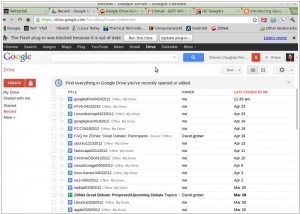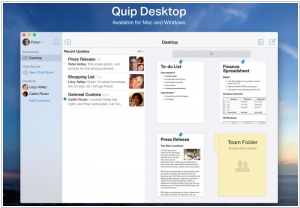Google Drive vs Quip
March 18, 2025 | Author: Adam Levine
29★
Online file storage and syncing service working as a file system for other Google's services. Allows to sync files between all your computers and mobile devices or collaborate on files with your team and partners. Version control, OCR, powerful online viewer. Provides 5 GB free disk space.
6★
Quip changes the way teams work together. Real work gets done, faster, smarter. Owned by Salesforce and integrated with Salesforce
Google Drive and Quip are both cloud-based collaboration tools, which is a fancy way of saying they let multiple people argue over the same document in real time without the need for carrier pigeons or yelling across the office. They store files, track changes and integrate with other software, presumably so that work can happen more efficiently, though the jury is still out on whether efficiency is a real thing or just a clever marketing gimmick. They also have apps, because in the modern era, everything must have an app, even things that don’t need one, like toasters and toothbrushes.
Google Drive, emerging triumphantly in 2012 from the mighty kingdom of Google, is primarily a storage service with collaboration features sneakily bolted on. It lets users hoard everything from spreadsheets to cat pictures with 15GB of free space, which disappears faster than you can say "high-resolution video." Its true power lies in its omnipresence—integrating with everything from Gmail to obscure third-party plugins, ensuring that no document is ever truly lost, just deeply, deeply buried. It’s perfect for businesses, students and people who need an extra place to store their terrible novel drafts.
Quip, on the other hand, appeared in 2013 and was promptly acquired by Salesforce, because everything in the universe must eventually be acquired by something larger and more ominous. Unlike Google Drive, which hoards, Quip thrives on structured teamwork, featuring built-in chat so teams can argue within the document itself rather than in a separate app. It’s particularly beloved by sales teams who enjoy integrating it with Salesforce CRM, probably because they have no other choice. While it lacks the vast file-storing prowess of Google Drive, it compensates with a more focused, conversation-driven approach, ensuring that everyone knows exactly who to blame when things go wrong.
See also: Top 10 Wiki software
Google Drive, emerging triumphantly in 2012 from the mighty kingdom of Google, is primarily a storage service with collaboration features sneakily bolted on. It lets users hoard everything from spreadsheets to cat pictures with 15GB of free space, which disappears faster than you can say "high-resolution video." Its true power lies in its omnipresence—integrating with everything from Gmail to obscure third-party plugins, ensuring that no document is ever truly lost, just deeply, deeply buried. It’s perfect for businesses, students and people who need an extra place to store their terrible novel drafts.
Quip, on the other hand, appeared in 2013 and was promptly acquired by Salesforce, because everything in the universe must eventually be acquired by something larger and more ominous. Unlike Google Drive, which hoards, Quip thrives on structured teamwork, featuring built-in chat so teams can argue within the document itself rather than in a separate app. It’s particularly beloved by sales teams who enjoy integrating it with Salesforce CRM, probably because they have no other choice. While it lacks the vast file-storing prowess of Google Drive, it compensates with a more focused, conversation-driven approach, ensuring that everyone knows exactly who to blame when things go wrong.
See also: Top 10 Wiki software




